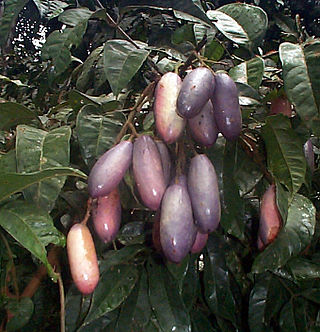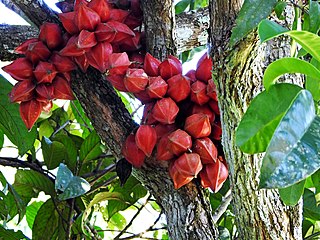
Canarium is a genus of about 100 species of tropical and subtropical trees, in the family Burseraceae. They grow naturally across tropical Africa, south and southeast Asia, Indochina, Malesia, Australia and western Pacific Islands; including from southern Nigeria east to Madagascar, Mauritius, Sri Lanka and India; from Burma, Malaysia and Thailand through the Malay Peninsula and Vietnam to south China, Taiwan and the Philippines; through Borneo, Indonesia, Timor and New Guinea, through to the Solomon Islands, Vanuatu, New Caledonia, Fiji, Samoa, Tonga and Palau.

Atalaya is a genus of eighteen species of trees and shrubs of the plant family Sapindaceae. As of 2013 fourteen species grow naturally in Australia and in neighbouring New Guinea only one endemic species is known to science. Three species are known growing naturally in southern Africa, including two species endemic to South Africa and one species in South Africa, Eswatini and Mozambique.
Canarium littorale is a tree found in tropical Asia and is a member of the incense tree family Burseraceae. The specific epithet littorale is from the Latin meaning "of the seashore", referring to its habitat.

Fagraea is a genus of plants in the family Gentianaceae. It includes trees, shrubs, lianas, and epiphytes. They can be found in forests, swamps, and other habitat in Asia, Australia, and the Pacific Islands, with the center of diversity in Malesia.
Kibara coriacea is a plant in the family Monimiaceae. The specific epithet coriacea is from the Latin meaning "leathery", referring to the leaves.

Dacryodes is a genus of about 60 species of trees in the family Burseraceae. The generic name is from the Greek dakruon meaning "tear(drop)", referring to how resin droplets form on the bark surface.

Dillenia alata, commonly known as red beech, golden guinea flower or golden guinea tree, is a tree in the Dilleniaceae family, found in tropical forests of the Moluccas, New Guinea, and northern Australia.
Canarium kinabaluense is a tree in the family Burseraceae. It is named for Mount Kinabalu in East Malaysia's Sabah state.
Canarium kostermansii is a tree in the family Burseraceae. It is named for the Indonesian botanist André Kostermans.
Canarium pilosum subsp. borneensis is a subspecies of Canarium pilosum. It is a tree in the family Burseraceae. The subspecies is named for Borneo.
Buchanania insignis is a tree of Borneo in the cashew and sumac family Anacardiaceae. The specific epithet insignis is from the Latin meaning "remarkable".
Dimocarpus fumatus is an Asian tree species in the family Sapindaceae.

Castanopsis argentea is an evergreen tree native to Indonesia, where it is known as sarangan. It is native to the islands of Java and Sumatra.
Bouea oppositifolia, also known as plum mango, kundang, kundangan or remenia, is a species of flowering plant, a fruit tree in the mango family, that is native to Indochina and Southeast Asia.
Ficus uncinata, also known as earth fig in English and as ara entimau in Iban, is a species of flowering plant, a fruit tree in the fig family, that is native to Southeast Asia.

Baccaurea angulata, also known as belimbing hutan or belimbing darah in Malay and more locally as ucong or embaling, is a species of flowering plant, a fruit tree in the tampoi family, that is native to Southeast Asia.

Baccaurea tetrandra, also known as mata kunau in Malay and more locally as kunau-kunau or enkuni, is a species of flowering plant, a tropical forest fruit-tree in the tampoi family, that is native to Southeast Asia.
Heliciopsis artocarpoides, also known as kurunggu or putat, is a species of flowering plant, a tropical forest fruit-tree in the macadamia family, that is native to Southeast Asia.
Lepisanthes multijuga is a species of flowering plant, a tropical forest fruit-tree in the lychee family, that is native to Southeast Asia.
Nephelium cuspidatum, also known as rambutan hutan in Malay and buah sibau in Iban, is a species of flowering plant, a tropical forest fruit-tree in the rambutan family, that is native to Southeast Asia.








